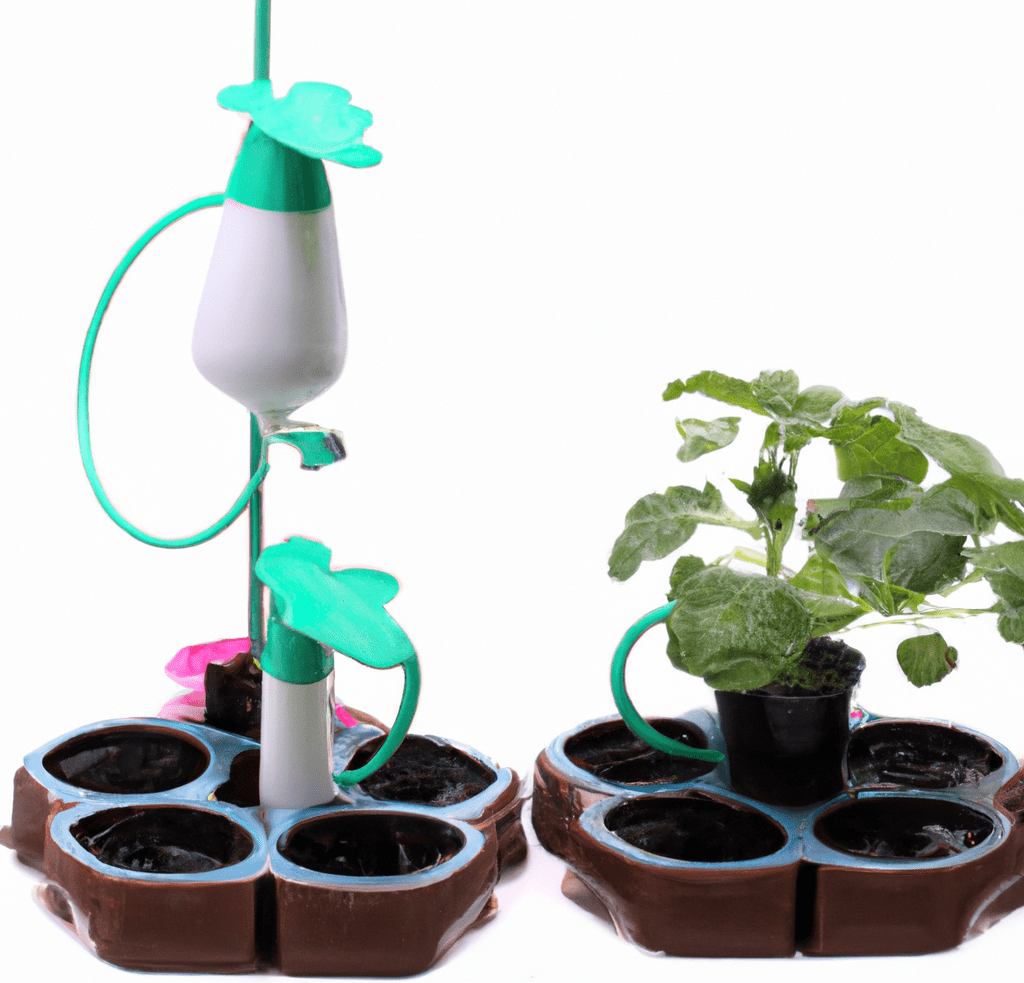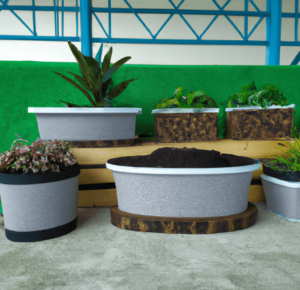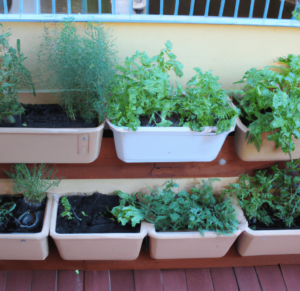Gardening is a rewarding hobby that calls for perseverance, commitment, and the appropriate equipment. Watering your plants is one of the most crucial components of gardening because it’s necessary for their growth and survival. Planters that self-water make it simple to water your plants and guarantee that they receive the proper amount of moisture. So, here are the benefits of self-watering planters!

What Are Self-Watering Planters
Using a wicking mechanism, the soil is connected to a water reservoir in self-watering planters. Capillary action, which is the flow of water molecules from the reservoir to the soil due to the tension of water molecules, is what draws water from the reservoir and into the soil as the soil dries up. This method eliminates the requirement for human watering by allowing plant roots to obtain water as needed.
They’re a fantastic option for gardeners, particularly those who are raising carnivorous plants or other species that are sensitive to changes in water levels.
Water Conservation
Conserving water is a crucial component of gardening, particularly when it comes to container gardening. Selecting drought-tolerant plants for your planters and pots is one easy method to save water. Additionally, using the right irrigation methods can significantly lower the amount of water required for your container garden.
Never leave standing water in the bottom of the container while watering your plants; instead, water them deeply and seldom. You can determine when to water by using a soil moisture meter. When you’re using planters to bring a small space to life, the benefits of self-watering planters may just convince you to get them.
How Self-Watering Planters Conserve Water
Self-watering planters are made to save water by giving the roots of the plants a constant supply of moisture. As a result, there is no longer a need to water frequently, and less water is wasted on evaporation or runoff.
A water reservoir is incorporated into the planter’s design to hold extra water and release it as the soil dries out. By doing so, it is made sure that the soil is always moist and that plant roots have access to water molecules when they are required. In turn, the plant experiences less stress and is better able to absorb nutrients from the soil. This results in a plant that is stronger and healthier, with fewer water-related issues like wilting, yellowing, or mortality. This is just one of the benefits of self-watering planters.
Comparison to Traditional Watering Methods
Watering from above while watering plant beds traditionally can cause water to evaporate and cause runoff. Contrarily, after you’ve designed and created a container garden, watering is more managed and has the extra advantage of a built-in reservoir in the pot.
Using a self-watering planter or a pot with a moisture-retentive layer at the bottom is a typical approach for container gardening. This lessens the requirement for daily watering and aids in maintaining constant moisture levels by allowing the plants to access water as needed. When compared to conventional watering techniques, these techniques can save time and resources, which is one of the benefits of self-watering planters that convinces people to use them.
Convenience
Self-watering planters provide gardeners with a practical answer by removing the requirement for frequent watering. The pot has an integrated reservoir that stores a water solution that continuously supplies the roots of the plants with moisture, minimizing the need for regular watering.
This not only saves time but also makes sure that even when the gardener is away, the plants get enough water. The benefits of self-watering planters also include peace of mind because the moisture level is controlled and consistent, unlike with planters where over- or under-watering can be serious problems.
How Self-Watering Planters Eliminate the Need for Daily Watering
Self-watering planters are an easy way to garden in containers because they don’t require regular watering. These planters have a built-in reservoir that stores water and provides access to it as needed for the plants. This lessens the possibility of overwatering or underwatering by preserving constant moisture levels in the container.
As a result of the reservoir’s ability to stop water evaporation, your plants will always have access to a supply of moisture. Gardeners can spend more time enjoying their container garden and less time watering by investing in the benefits of self-watering planters. These planters can offer a low-maintenance alternative that supports the growth of your plants when set up properly.

Suitability for Busy Lifestyles
The benefits of self-watering planters include being a great option for time-pressed gardeners who might not have the energy or time to routinely water their plants. These planters give the plant roots an ongoing supply of water thanks to an integrated reservoir and a potting mix that retains moisture, even if you forget to water them for a few days. This is crucial for carnivorous plants in particular since they need a particular balance of soil and water to survive.
Self-watering pots, as opposed to conventional garden beds, take the guesswork and worry out of trying to manage the delicate water balance in the soil and guarantee that your plants always have the proper number of water molecules.
Plant Health
Self-watering pots offer the soil and plant roots a reliable and efficient source of water. The planters contain a reservoir that aids in preserving the correct humidity level, making sure that water molecules are readily available to the plant roots.
Particularly for species like carnivorous plants that have particular moisture requirements, this leads to healthier, stronger plants. The benefits of self-watering planters include the fact that you won’t have to worry about the plants getting too dry or too wet, which will improve the health and longevity of the plants.
How Self-Watering Planters Promote Healthy Plant Growth
These planters not only cut down on daily watering but also encourage strong plant development which is one of the benefits of self-watering planters. The presence of a built-in reservoir ensures that the plant roots always have access to moisture, which is necessary for strong growth. Additionally, the ongoing availability of moisture contributes to ensuring that the plants get the nutrients they need to flourish. This is particularly advantageous for carnivorous plants because they need a certain amount of moisture to survive.
Gardeners who use self-watering planters can give their plants a consistent atmosphere that promotes healthier growth and a more colorful container garden. Self-watering planters can offer a solution that encourages healthy plant growth while also lessening the strain for gardeners with the proper setup.
Explanation of the Sub-Irrigation System
A sub-irrigation system used in self-watering planters keeps the roots of the plants consistently moist without overwatering. This is accomplished by having a water reservoir at the base of the planter and wicking material that draws moisture from the air and into the soil. The water is then brought up into the soil as the plant roots require it, giving the plants a steady and consistent environment.
Through regular moisture delivery, less stress, and stimulation of healthy root growth, this system aids in the maintenance of the plant’s health. When water is allowed to lie in the soil for a lengthy period of time, water-borne diseases may develop, but the sub-irrigation system aids in lowering that danger. This is another one of the benefits of self-watering planters.
Cost Savings
Comparing self-watering plants to conventional watering techniques can result in significant financial savings. By reducing the need for daily watering, the built-in reservoir can help save time and resources. Additionally, the water reservoir’s consistent moisture supply encourages healthy plant growth and root development, lowering the need for additional fertilizers and soil additives.
As a result, keeping a container garden may cost less overall is one of the benefits of self-watering planters. Gardeners may provide their plants with a healthy, low-maintenance habitat while also saving money by using self-watering planters because they use less water and fertilizer.
How Self-Watering Planters Save Money on Water and Plant Replacements
Self-watering planters are made to supply the proper amount of water to plants, hence minimizing the frequency of watering. These planters aid in preventing over- or under-watering, which can injure plants and cause them to wilt or die, by managing the water levels in the soil. This entails that you can spend less money on water and on replacing plants that fail due to insufficient irrigation.
In self-watering pots, the sub-irrigation system helps maintain soil moisture and encourages healthy plant growth, minimizing the need for regular watering and ensuring your plants thrive in their surroundings.
Types of Self-Watering Planters
Wicking beds, sub-irrigated planters (SIPs), and smart planters with water reservoirs are a few of the most popular types that you can use if you want to reap the benefits of self-watering planters:
- Wicking beds are sizable receptacles filled with soil and absorbent material, like felt or sponge. The roots of the plants receive a steady supply of water from the soil thanks to this substance, which draws moisture up from the reservoir at the bottom.
- A water reservoir is located at the base of sub-irrigated planters (SIPs), and it is connected to the soil by tiny tubes or channels. As a result, there is no need to water plants frequently because water can seep up into the soil and reach the roots of the plants.
- Smart planters utilize sensors to track the soil’s moisture levels and water the plants automatically as needed. For busy gardeners who lack the time to monitor watering schedules, these pots are perfect.
Self-watering planters are perfect for a variety of plants, including herbs, flowers, vegetables, and even carnivorous plants, when it comes to compatible species. Nevertheless, it’s crucial to select the proper kind of self-watering planter based on the size of the plants and how much water they demand.
Bottom Line: The Benefits of Self-Watering Planters
Self-watering planters offer a practical and successful answer for container gardening. The benefits of self-watering planters include helping to encourage healthy plant growth by lowering the need for daily watering, especially for carnivorous plants that require particular moisture levels to survive.
Self-watering planters can deliver a more controlled and effective method for watering your container garden thanks to the added benefit of an integrated water reservoir. Self-watering planters’ innovative design enables a low-maintenance and economical alternative that can assist you in developing a flourishing container garden.
Consider checking more sources or getting in touch with a local gardening professional for more details on self-watering planters and other gardening solutions. When planning your next gardening project, think about including self-watering planters in your layout. Self-watering planters can help you build a healthy and flourishing container garden that requires less time, effort, and resources thanks to the many advantages they offer.
The Benefits of Self-Watering Planters FAQs
Self-watering planters: what are they?
Self-watering planters are containers with a built-in water reservoir that maintain soil moisture by a wicking mechanism. The reservoir is attached to the soil, and as the soil dries, water is absorbed through capillary action into the soil from the reservoir. As a result, there is no longer a requirement for frequent hand watering and the plant roots may get to the water as needed.
Why is gardening benefited by self-watering planters?
Numerous advantages of self-watering planters include their ability to conserve water, simplicity, and adaptability for busy lifestyles. Additionally, they aid in reducing the chance of over- or under-watering, both of which have a detrimental effect on plant health. Self-watering planters are another low-maintenance option for container gardening that can free up gardeners’ time to appreciate their plants.
Self-watering planters: How do they save water?
Self-watering planters save water by providing a steady flow of moisture to the roots of the plants, avoiding the need for frequent watering. The extra water is stored in the built-in water reservoir, which releases it as needed to keep the soil moist and provide the plant roots with water when they need it. As a result, the plant becomes stronger and healthier with fewer water-related problems.
How do self-watering planters get rid of the requirement to water them every day?
Self-watering planters have an integrated water reservoir that stores water and gives the plants access to it as needed. This prevents overwatering or underwatering by maintaining regular moisture levels in the container. Because of this, self-watering planters are a simple and low-maintenance option for container gardening.
Do self-watering planters work well for those who lead busy lives?
Yes, self-watering planters are a terrific choice for time-pressed gardeners who might not have the energy to water their plants frequently. Even if the gardener forgets to water the plants for a few days, the roots will always have access to water because of the built-in water reservoir and moisture-retaining potting mix.
How do self-watering planters affect the well-being of plants?
Self-watering pots offer a dependable and effective source of water for the roots of the plants. The integrated water reservoir aids in maintaining the ideal relative humidity, making sure that water molecules are accessible to the plants. As a result, the plant becomes stronger and healthier and experiences fewer problems with water.







